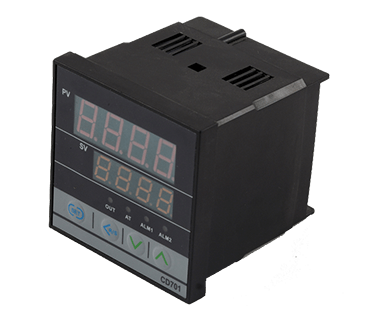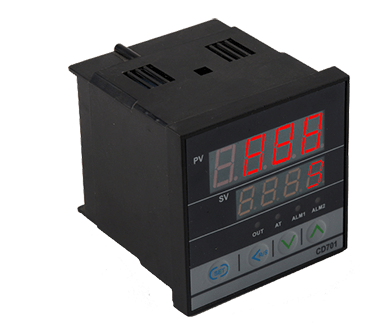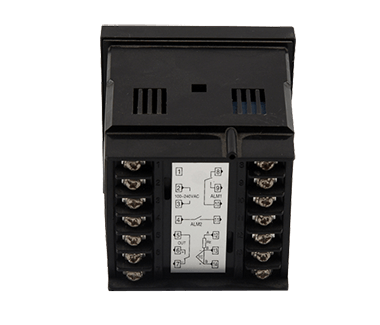This series instruments are intelligent double-row four-digit display instruments, which display measured values and set values respectively. They can input a variety of signals. The instrument is equipped with four-button operation, easy parameter setting and convenient input of information. The control method have two-position control and PID control. The instrument adopts super anti-interference chip design and the quality is reliable.
The control modes have PID control and position control (also known as the hysteresis control or the upper and lower limit control). The PID control is a professional control method suitable for industrial control situations requiring high precision measurement control. PID is the abbreviation for proportion, integral, and differential. PID control combined the advantages of the three and have the function of timely and rapid proportion action, the ability to eliminate residuals with integral action, and the advanced control function of differential action. In addition, the self-tuning function of the meter can automatically calculate the optimal P.I.D. parameter value according to the control effect of the controlled object and automatically save it.
This series instruments are also with high cost performance.
Heating/Cooling control
Digital communication
Heating/Cooling control
Auto adjusting function
Digital communication
Big screen LED display
Industrial tandard microcomputer processor
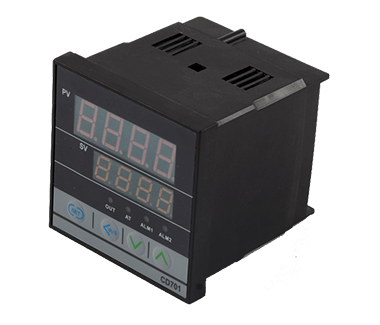
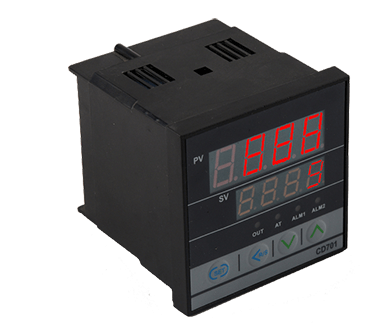
1.Outline dimension | See the outline dimension picture | |
2.Control Mode | F:PID operation and auto calculating (reverse operation) | D:PID operation and auto calculating(Forward operation) |
W:eating/cooling PID operation and auto calculating(cooling water)*1 | A:heating/cooling PID operation and auto calculating(cooling water)*1 | |
3.Input mode | Refer to Input Range Table | |
4.Range Code | Refer to Input Range Table | |
5.First control | M: Relay contact output | 8: Current output(IC4-20mA) |
6.Second control | No mark: when the control mode is F or D | T: Thyratron output |
7.First alarm(ALM1) | N: no alarm | J: lower-limit input alarm |
9.Communication*5 | N:No communication | 5:RS-485(two-wire system) |
10.Water-proof/dust-proof | N:no water-proof/dust-proof | 1:with water-proof/dust-proof |
Refer to Input Range Table |
Input type | Set range | Input type | Set range | |
Thermocouple Input(TC) | K | 0 to 1372°C(0 to 2502 F) | J | 0 to 1200°C(0 to 2192 F) |
R | 0 to 1769°C(0 to 3216 F) | S | 0 to 1769°C(0 to 3216 F) | |
B | 0 to 1820°C(0 to 3308 F) | E | 0 to 1000°C(0 to 1832 F) | |
N | 0 to 1300°C(0 to 2372 F) | T | -199.9 to +400.0°C(-199.9 to +752.0 F) | |
W5Re/W26Re | 0 to 2320°C(0 to 4208 F) | PL | 0 to 1390°C(0 to 2534 F) | |
L | 0 to 900°C(0 to 1652 F) | U | -199.9 to +600.0°C(-199.9 to +999.9 F) | |
RTD Input Pt | 100Ω(JIS/IEC) | -199.9 to +649.0°C | JPt100Ω(JIS) | -199.9 to +649.0°C |
Voltage input | 0 to 5V DC | 1 to 5V DC | -1999 to +9999(programmable range) | |
Current input | 0 to 20mADC | 4 to 20mADC | -1999 to +9999(programmable range0)
| |

